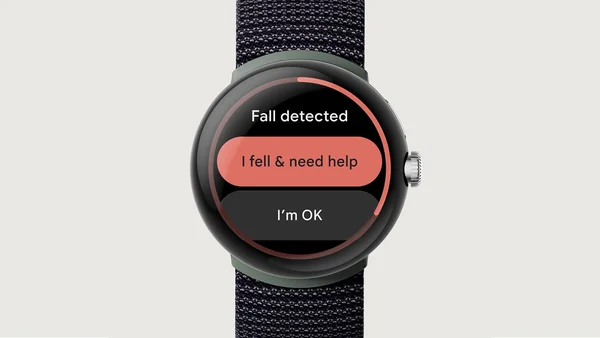How Google Pixel Watch knows when you fall

Fall detection on Google Pixel Watch 1 is one of our latest safety features. If your watch detects you’ve taken a hard fall and haven’t moved for around 30 seconds, it will vibrate, sound an alarm and send a notification asking if you’re okay. After about a minute, if you still haven’t moved or responded, the watch will automatically call emergency services and share your location. 2

But how exactly can your watch determine if you’ve fallen down a flight of stairs and need help or if you’re just doing burpees? From motion sensors and AI algorithms to stunt doubles, here’s a look at how fall detection works and how we built it to be as helpful as possible.
Sensing motion from inside your watch
Pixel Watch is packed with small sensors that collect data to inform all the helpful features. For example, the sensor that tracks your heart rate helps determine your sleep quality. And the sensor that detects how much ambient light there is in your environment tells your watch to adjust the display to be brighter or less bright so you can see the screen clearly. For the fall detection feature, the watch uses motion sensors to look for your body’s instinctive reactions to a fall, like how you might move your arms on the way down, and the impact force of a fall.
But there’s a catch: Lots of the movements people make every day have similar motion patterns to a serious fall. You might take a small stumble during a pick-up soccer game, for instance, or do jumping jacks during a workout — neither of which constitute an emergency.
To be as helpful as possible and minimize false detections, the Pixel Watch engineering team created AI algorithms to tell the difference between a hard fall where you might need help, and a movement that only mimics falling but isn’t serious. Step one in creating those algorithms: Collecting the data.
Teaching AI algorithms to detect hard falls
“By collecting a lot of data and training our AI models across different data sets, we can differentiate between different types of motion patterns,” says Paras Unadkat, the product lead for the fall detection feature. “But you can't exactly ask people to just go and take falls for your data without any safety precautions.”
So, the team had to get creative with how they gathered fall data. Early on, they worked with labs (at universities and elsewhere) that were already researching what falls look like to motion sensors. “We had people come into the lab and set them up on elaborate rigs to see how they reacted to losing balance so we could understand the different components of a fall,” says Paras.
But a lot of factors can impact how sensors interpret falls. For example, if someone takes a fall on a crash pad, it doesn't look just like a real-life fall because the impact is less intense. So the Pixel Watch team turned to computer vision for help visualizing a variety of tumbles. First, they worked with another research team at Google to analyze videos of real-life falls. Then, they simulated those physics while also accounting for factors that may change what a fall looks like — from different limb lengths and body types to what surfaces people may land onto.
After assembling all this data and incorporating it into the fall detection algorithms, the team set out to test how the AI held up in real-world scenarios. One of their tactics took a page from the Hollywood playbook: They worked with stunt doubles in LA for a week, directing them to take different types of falls while wearing Pixel Watches.
Making calls for help when you need it
Once the team was confident the fall detection feature worked well, they tested it on several hundred people for over a year to make sure it didn’t inundate emergency services with false alarms. This group of testers wore the watch while doing high-energy activities — like jumping, swimming and doing burpees — to make sure those movements didn’t trigger alerts. The emergency dispatch community also helped test that the watch’s automatic calls were as clear and helpful as possible.
Now that you know how Pixel Watch’s fall detection feature works, all that’s left to do is turn it on. You can do this directly on the Pixel Watch (go to Personal Safety, then Fall detection to enable Fall Detection) or in the Watch Companion app under Watch Preferences, tap on Safety & Emergency . Be sure to grant location permission for fall detection so the feature can share your location if needed with emergency services. And if you want to help the fall detection algorithms improve over time, you can toggle on the “Help improve fall detection” setting. After that, your watch’s motion sensor data may be part of making this safety feature even more useful in the future.








